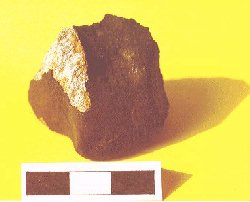|
|
Marco Langbroek Information on meteorites How to recover meteorites Reporting a meteorite fall Meteorite falls investigated by DMS-members |

Meteorites are enigmatic pieces of matter left over from the bygone days of solar system formation, mysterious travellers both in time and space. There's a lot to be learned from them by scientists, who call themselves 'meteoriticists' when specializing on this subject. Meteorites can be true 'Rosetta stones' in deciphering the early history of our solar system and the formation of our planet.
If you believe you have found a new meteorite, it surely is worth to have it investigated. Below, you can report your find to the Dutch Meteor Society, who can help you solving the (often difficult!) question whether it is a genuine meteorite or not and can bring you in contact with scientist investigators. You can either directly fill in the Meteorite report sheet, but we encourage you to go through the checklist contained in the short guide for the recognition of meteorites first before filling it in: many alledged 'meteorites' turn out to be natural stones or Man-made products in reality, and the guide on this page can help you avoiding misidentifications.

Above: a 46 grams specimen of the Mbale (Uganda, central Africa) L6 chondrite (ordinary stony meteorite), showing a thin exterior greyish-black fusion crust and some of the light grey, iron-specked interior. The scale bar is in cm. From the strewn field of this large fall, which occured at August 14, 1992, over 1000 specimens with a total weight nearing 200 kg have been recovered by Hans and Jan Betlem in collaboration with local scientists, and fieldwork in the strewnfield by coworkers (mostly Jan Betlem) of DMS is still continuing. The largest recovered specimen weights 27 kg, the smallest (fully fusioncrust covered) 0.01 grams! During the fall event, a young boy was hit on the head by a 3.6 grams specimen, but he luckily survived because the small specimen was slowed down as it hit a banana tree before it hit the boy. An initial account of the fieldwork and mineralogical research can be found in Meteoritics 29 (1994), p. 246-254 (photograph: M. Langbroek, Dutch Meteor Society, Meteorite Recovery Project).